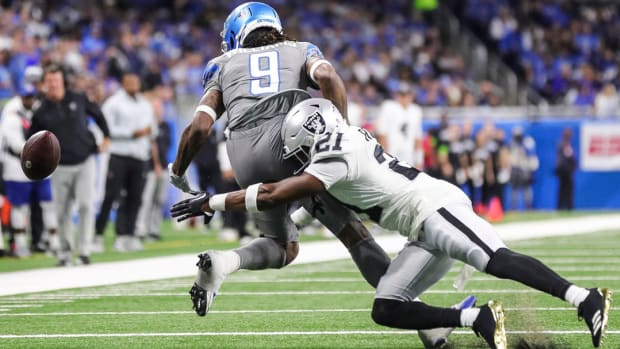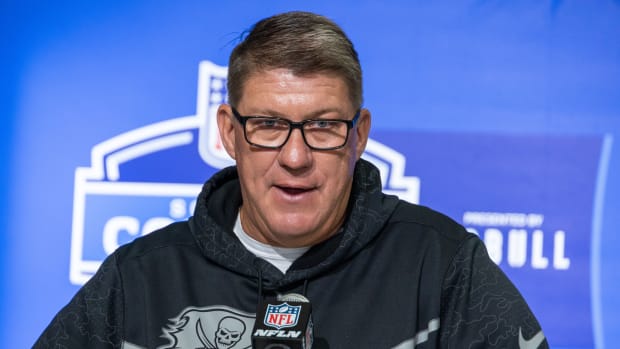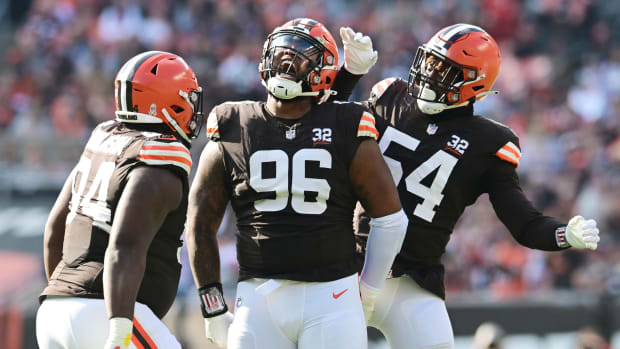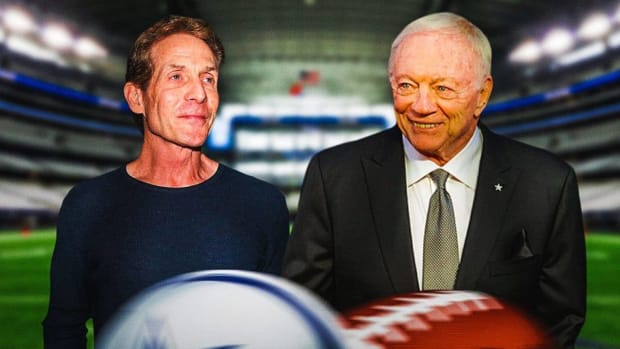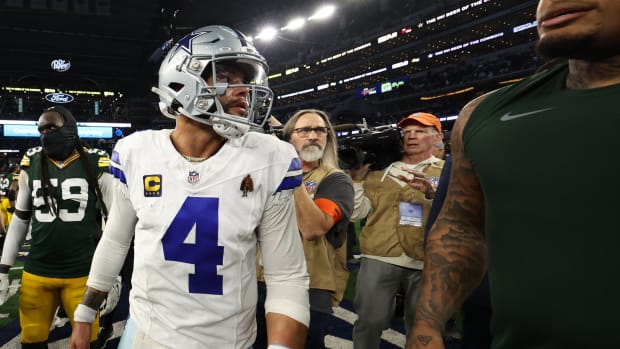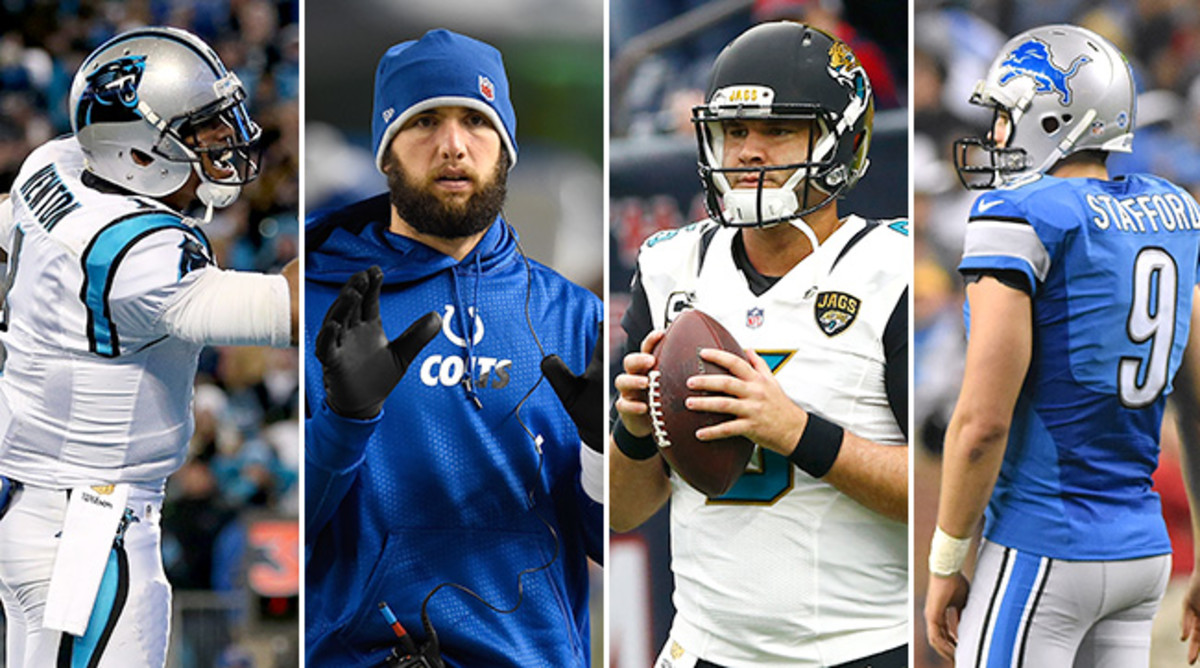
Quarterback Fantasy Rankings
Welcome to Fantasy 40, The MMQB’s new (but not necessarily improved) fantasy football column.
Every Tuesday afternoon during the regular season, I’ll have a forward-looking rundown of the 40 players fantasy owners need to know about: top waiver wire picks, buy-low and sell-high trade candidates, or guys looking at unexpectedly tough or easy matchups in the coming week(s).
Now, I know what some of you are thinking…
And that’s fine. Frankly, there’s nothing you can say to me that I haven’t already heard while on the receiving end of a swirly in the eighth grade. I’ve been playing fantasy football since 1988, when I was nine years old, when we had to score games by hand and, if the highlight didn’t run on ESPN’s Primetime, wait until the next morning’s newspaper to see if it was Andre Reed, James Lofton or Pete Metzelaars who caught that fourth Jim Kelly touchdown. Nearly three decades later I’ve found fantasy football to be an industry that, while wildly popular, is dominated by a stale groupthink mentality. As I roll out position rankings this week, I’ll address portions of that at the top of each column, and introduce ways you can make your league better.
* * *
So, about that stale groupthink thing… Before we get into the rankings, let’s take a moment to fix your crappy league. The value of a touchdown pass is a good place to start.
A touchdown pass should be worth six points, not the “standard” four. The only argument to counter this is: Well, it’s always been four. That some 20 players, half of them running backs, can hold higher consensus value than the top quarterbacks in any activity branding itself as “football” in 2016 is the definition of insanity.
Fantasy leagues need to do something to recognize that quarterbacks are exponentially more valuable than running backs in the modern NFL. I’d go so far as to say passing yardage should be significantly increased, but, well, baby steps. The biggest pushback against six-point TD passes is that it will overinflate QB point values. However, consider this:
Let’s say the average (competitive) league has 14 teams. Using standard scoring: a point for every 10 rushing/receiving yards, every 25 passing yards, six points for rushing/receiving TDs and a half point per reception (and if, after all these years, you still haven’t figured out that half a point per reception is the way to go then I don’t even know why we’re friends).
Now, stay with me here, because this is math. You have 14 starting QBs in a 14-team fantasy league, as well as 28 starting running backs and 28 starting receivers. Looking at last year’s numbers, on a per-game basis, here are the values for (1) the top player, and (2) the median player (an average of Nos. 14 and 15 for RBs and WRs, and an average of Nos. 7 and 8 for QBs, in other words, an average starter) over the top bench player (aka “replacement player,” the 29th RB and WR, and 15th QB) at each position:
4-POINT TD PASSES | QB | RB | WR |
Top Player Value Over Best Bench Player | +7.04 | +8.78 | +8.58 |
Median Starter Value Over Best Bench Player | +1.42 | +2.59 | +3.28 |
6-POINT TD PASSES | QB | RB | WR |
Top Player Value Over Best Bench Player | +7.78 | +8.78 | +8.58 |
Median Starter Value Over Best Bench Player | +1.55 | +2.59 | +3.28 |
Quarterbacks typically offer more consistency and durability than other positions, especially running backs. But, come on. It’s way past time for fantasy football to recognize the top players in real life, and adjust the scoring system to do so. Six-point TD passes at least begin to address that.
Alright, let’s go to the frickin’ rankings...
* * *
1. Cam Newton, Carolina
The Panthers have no real reason to get away from the handful of designed power runs they call each game with Newton. His numbers as a runner give him a huge boost, and he gets Kelvin Benjamin back after throwing for 35 touchdowns with what might have been the least talented group of wide receivers in football (though, admittedly, one that fits Carolina’s system nicely).
2. Andrew Luck, Indianapolis
Back where I’m from (America) we have a term for performances like Luck’s 2015: “a crapping of pants.” And yet, on a per-game basis, Luck was still 11th among fantasy quarterbacks last season. Health, plus some moves to solidify the O-line, plus the continued maturation of Donte Moncrief and Phillip Dorsett, plus a lack of any depth in the backfield behind a 74-year-old Frank Gore should result in an MVP-caliber stat line for Luck.
3. Russell Wilson, Seattle
After losing Jimmy Graham (and with Marshawn Lynch already out), the Seahawks went to a redesigned spread attack that had Wilson getting the ball out quickly. Playing in the revamped system from Thanksgiving on, Wilson averaged 274.3 passing yards per game with a 21-to-1 TD/INT ratio over six games, and that was without a potential red-zone monster in Graham.
4. Aaron Rodgers, Green Bay
Jordy Nelson is back, and with a full offseason to figure out how things ended up in the toilet last year, Rodgers should be fine. Though I do spend my idle time worrying about the home/road splits: 4,456 yards, 42 TD, 4 INT at home the past two regular seasons; 3,746, 27 TD, 9 INT on the road (16 games for both splits).
5. Ben Roethlisberger, Pittsburgh
I could envision a future in which the U.S. converts to the metric system, and Roethlisberger is the top-scoring quarterback in fantasy football. However, the thought of Le’Veon Bell (when eligible) taking a hefty dose of red zone touches and Roethlisberger’s permanent spot on Pittsburgh’s injury report give me pause.
6. Drew Brees, New Orleans
I’m not about to claim this is the year Brees slows down, but his performance on the road last season (2,017 yards, 9 TDs in seven games) suggests his dwindling arm strength is becoming a problem, at least outside the Superdome.
7. Carson Palmer, Arizona
Yes, Palmer was a trainwreck down the stretch. But he had an offseason to heal the injured thumb on his throwing hand, and he remains a great fit in Bruce Arians’ offense, one loaded with weapons.
8. Eli Manning, N.Y. Giants
Another year in Ben McAdoo’s system, and in Sterling Shepard the Giants have finally added a legitimate No. 2 receiver. Plus, there’s no reason to think the Giants will be able to run the ball any better than they did a year ago, so expect them to throw it more than 60 percent of the time again this year.
9. Philip Rivers, San Diego
The Chargers can’t run the ball and their defense remains a huge question mark, so say a prayer for Rivers’ rotator cuff. He’s poised to lead the league in pass attempts for a second straight year (and last year he became the third quarterback ever to drop back 700 times in a season). A healthier supporting cast and the addition of an underrated deep threat in Travis Benjamin give Rivers a chance to be much more effective with that huge workload.
10. Tom Brady, New England
He’ll miss the first four games, but whatever. Dante Scarnecchia will have an extra month to teach that team how to block. If your fantasy league does in-season playoffs (and you’re lame if you do, but we’ll get into that later) you could make Brady the fifth or sixth QB off the board and still sleep soundly at night.
11. Blake Bortles, Jacksonville
I’m sure he’ll take another step forward in his development. But the Jaguars’ D is poised to make a leap one year after it allowed more first-half points than any other in football, making Bortles’ league-leading 23 second half/OT TD passes a necessity. And the Jags brought in Chris Ivory to run the ball, not because they thought his name suggested he was a talented pianist. Bortles will be reined in from a pass attempt standpoint in 2016.
12. Tyrod Taylor, Buffalo
He had more rushing yards per game (40.6) than any other quarterback last season, and you get the feeling the Bills don’t mind the risk/reward with putting Taylor on the run eight or so times every week. If Sammy Watkins is in the lineup for 16 games to carry Taylor and the passing game, then, as they say in Western New York, “In Rod We Trust.” (They don’t say that in Western New York, but my friend Dan came up with it and he’s hoping it catches on.)
13. Kirk Cousins, Washington
The Gruden/McVay system is a quarterback’s dream. And the addition of Josh Doctson and, presumably, expanded roles for Matt Jones and Chris Thompson (both superior passing game options to the departed Alf Morris) should result in another big year for Cousins.
14. Andy Dalton, Cincinnati
No Hue Jackson and, at least for the first part of the year, no red-zone monster Tyler Eifert. The downgrade in weapons is enough to back off Dalton as a mid-lever fantasy starter.
15. Jay Cutler, Chicago
He’s fine as long as Alshon Jeffery is around, and the arrival of Kevin White, another big-bodied guy who plays to Cutler’s tendencies as a “see-it” quarterback, makes this a very interesting receiving group. Plus, The MMQB’s Kalyn Kahler, making her fantasy football debut this year, has already sworn she will take Cutler as her quarterback. (If you’re in Kalyn’s league, please strike the preceding sentence from your memory.)
16. Ryan Tannehill, Miami
Adam Gase brought out the best in Jay Cutler. And even if he doesn’t do quite the same with Tannehill, Gase has always skewed pass-heavy with his play-calling. Tannehill should put up career-best totals simply because of that.
17. Jameis Winston, Tampa Bay
Lots of play-action, lots of chucking it deep to his NBA frontline-sized receiving corps. Jameis will be a little bit boom or bust on a week-to-week basis, but if Dirk Koetter trusts him a little bit more in the red zone he could emerge as a fantasy QB1.
18. Matthew Stafford, Detroit
Calvin Johnson’s not walking through that door. But neither is Barry Sanders, and the Lions will still lean heavily on Stafford and the passing game to move the ball.
19. Derek Carr, Oakland
I will likely be the last one to step aboard the Derek Carr bandwagon. I like the pairing with Amari Cooper. I’m just not sold that Carr can consistently put up numbers.
20. Tony Romo, Dallas
Sure, Romo to Dez might be the best red-zone combination in the league, so Romo has a shot at 30-plus TD passes. But the Cowboys will do whatever they can to keep their dreadful front seven on the sideline, and that means one of the NFL’s most run-heavy attacks. The yardage upside just isn’t there for Romo.
21. Marcus Mariota, Tennessee
We’re still trying to figure out just how good he can be, and Mariota’s potential as a runner (even if the Titans don’t want him running the ball) is intriguing. But this is a team desperate to establish the run.
22. Joe Flacco, Baltimore
Meh. Steve Smith Sr. coming off a ruptured Achilles. Benjamin Watson and Mike Wallace. That’s not a fantasy QB1’s arsenal.
23. Matt Ryan, Atlanta
Well, things can’t get worse than last year (in fact, the Falcons were so upset with their quarterback that they took all that cap space and spent it on Mohamed Sanu, leaving Atlanta with a group of similarly punchless options opposite Julio Jones). Ryan should improve in Season 2 under Kyle Shanahan, but considering how effective the run game has been in the red zone, the ceiling is low.
24. Robert Griffin III, Cleveland
The Browns are going to get hammered week after week. There’s even some hope RG3 won’t be quite as erratic under QB whisperer Hue Jackson. It would be no surprise if Griffin pulled together some fantasy heroics in garbage time.
25. Ryan Fitzpatrick (free agent)
The season’s dullest contract standoff will surely end up with Fitzpatrick starting under center for the Jets. Or will it? (Nah, it will.) The question is, considering his career arc and the disastrous season finale, can the Boston University (or was it Brandeis?) alumnus possibly match the career numbers he posted in 2015? I know the answer, but I’m not telling.
26. Brock Osweiler, Houston
He couldn’t hold off the decrepit right arm of Peyton Manning in Denver, and his weaponry won’t be nearly as good in Houston.
27. Blaine Gabbert, San Francisco
I actually kinda like Gabbert as a risk/reward guy. The Niners’ receivers are nothing to write home about. (But, then, would you ever really write home about an NFL team’s receiving corps? Well, maybe if Hart Lee Dykes was involved.) But San Fran figures to be trailing in games early and often, and Chip Kelly’s uptempo system gives Gabbert a chance to accumulate some numbers.
28. Alex Smith, Kansas City
I actually have some respect for Smith as a bye week fill-in. He’ll get a little boost from rushing yards every week, and he won’t implode and turn it over. Low reward, but almost zero risk. You could do worse in a bind.
29. Sam Bradford, Philadelphia
Did you have a sleepless night, wondering where Sam Bradford is ranked among fantasy quarterbacks? Well, good news: I have your answer. Twenty-ninth. Sam Bradford is ranked 29th.
30. Mark Sanchez, Denver
I mean, what do you want me to say? He’s probably going to start. And he’s probably going to throw a lot of screen passes to Demaryius Thomas.
31. Teddy Bridgewater, Minnesota
All AD all the time in Minnesota. (You know Adrian Peterson’s nickname is AD, for “All Day,” right? Not AP. That would be boring.) And the Vikings’ defense won’t put Bridgewater and the offense in trail position very often, so no reason to stray from the script.
32. Jared Goff, Los Angeles
They have a superstar running back, cruddy receivers and a rookie quarterback from an Air Raid offense facing an NFC West slate. The Rams might literally not throw a single pass in 2016.
33. Colt McCoy, Washington
Washington might have the most QB-friendly system in the NFL, and there’s really not that much separation between McCoy and Kirk Cousins. (Not that I’m advocating for a quarterback controversy.) McCoy is the only real-world backup who would have a shot at top-15 fantasy value if promoted to the starting lineup.
34. Jimmy Garoppolo, New England
I mean, you’re not going to start him Week 1 at Arizona, right? So how much do you want to invest in three games of Garoppolo?
35. Colin Kaepernick, San Francisco
“Holding Clipboard for Gabbert” is going to be the title of my band’s next album. It will be a very sad album. Also, I don’t have a band.
36. Paxton Lynch, Denver
I suppose he could have some value late in the year, seeing as Paxton can make plays with his legs and would get plenty of help from Demaryius Thomas and Emmanuel Sanders.
37. Cody Kessler, Cleveland
It seems like he’s the closest thing to a “Quarterback of the Future” in Cleveland. The rookie comes from a pro system, and if Hue Jackson could make Andy Dalton and AJ McCarron into passable NFL starters, Kessler has a chance.
38. Trevor Siemian, Denver
Between you and me: The first time I tried to spell “Siemian” for this piece, I had three of the four vowels incorrect.
39. Carson Wentz, Philadelphia
He’ll be a good quarterback one day. He won’t be a good quarterback as long as Jordan Matthews and Nelson Agholor are his starting receivers.
40. Geno Smith, N.Y. Jets
If your league bylaws stipulate that you must have at least one “Geno” on your roster, this is the guy you want.
Question or comment? Email us at talkback@themmqb.com.
































